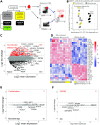Characterisation of clinical response and transcriptional profiling of proliferating CD8 T cells in the blood of cancer patients after PD-1 monotherapy or combination therapy
- PMID: 39886145
- PMCID: PMC11235052
- DOI: 10.1136/bmjonc-2024-000328
Characterisation of clinical response and transcriptional profiling of proliferating CD8 T cells in the blood of cancer patients after PD-1 monotherapy or combination therapy
Abstract
Objective: Immune checkpoint inhibitors (ICI) that block the programmed cell death 1 (PD-1) pathway have shown promise with limited benefit. We and others have shown in small patient cohorts that an early proliferative CD8 T-cell response in the blood may be predictive of clinical response. However, these studies lack detailed analyses and comparisons between monotherapy and combination therapies.
Methods and analysis: We analysed longitudinal blood samples from 103 patients with cancer who received αPD-1 monotherapy or combined with anti-cytotoxic T lymphocyte-associated protein 4 (αCTLA-4) or chemotherapy. Transcriptional analysis of CD8 T cells after the first treatment cycle with effector cells generated following yellow fever virus (YFV-17D) vaccine-induced infection was also compared.
Results: An early proliferative (Ki-67+) CD8 T-cell response was observed after cycle 1 in 60 patients (58.3%). Patients with early-and-sustained proliferative responses (cycle 1 and beyond) had better clinical responses and survival than patients with an early-but-limited response (p=0.02). The proliferating cells had an effector-like phenotype. The transcriptional profiles of the effector-like CD8 T cells were similar irrespective of treatment type or clinical response but distinct from that of YFV-specific effector CD8 T cells.
Conclusions: Our data suggest that early proliferative CD8 T-cell response in the blood is predictive, and that an early-and-sustained proliferative response may further identify patients with prolonged survival. The ICI-induced effector-like CD8 T cells are transcriptionally distinct from highly functional YFV-specific cells, suggesting opportunities for improved T-cell effector function with combination therapies for better clinical outcome.
Keywords: Biomarkers; Immunotherapy; T-lymphocytes.
© Author(s) (or their employer(s)) 2024. Re-use permitted under CC BY-NC. No commercial re-use. See rights and permissions. Published by BMJ.
Conflict of interest statement
Competing interests: RA has patents related to the PD-1 inhibitory pathway.
Figures





References
LinkOut - more resources
Full Text Sources
Research Materials
